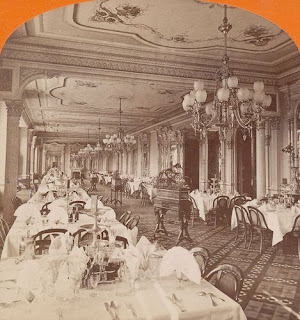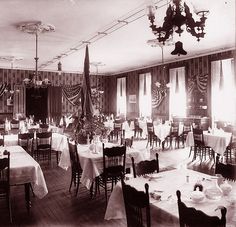In early America there were taverns, inns, and boarding houses that offered supper, but there were no restaurants. Delmonico's, the first American restaurant, opened in 1831 in New York City. Along with a growing population, the number of restaurants grew with the patrons exclusively male!
Thursday, November 25, 2021
Thanksgiving A la Carte - by Jo-Ann Roberts
In early America there were taverns, inns, and boarding houses that offered supper, but there were no restaurants. Delmonico's, the first American restaurant, opened in 1831 in New York City. Along with a growing population, the number of restaurants grew with the patrons exclusively male!
Monday, November 22, 2021
NEW RELEASE: Figgy Pudding by Francine - by Zina Abbott
Today, I'm pleased to announce the release of
Figgy Pudding by Francine
by Zina Abbott
Old Timey Holiday Kitchen Book 9
About Figgy Pudding by Francine:
Francine Mulder’s life in 1878 has experienced a series of ups and downs—all because she allowed one of the benefactors of the Albany Elite Academy for Girls to raise a hope that she can attract a man willing to marry a spinster math and science teacher. She received a letter in effeminate handwriting. Was the letter from him, or did a woman write on his behalf? After taking the chance that she might like the physical science instructor better once she learns more about him―assuming he chooses to personally respond―she takes the chance and answers. She even travels to Denver and attaches herself to an all-female scientific expedition so she will have more to write about that he might find interesting. All summer she waits in vain for a reply. Just before the autumn term starts, she receives a letter but not from the same man.
Jason Sewell, a full professor of science and astronomy at the University of Iowa, is a widower with no interest in the young female students who often flock around him. He has no intention to marry again. Then, he takes a trip to Rawlins, Wyoming to view a total solar eclipse. During the weeks of hunting and exploring that follows, his friend—from whom his mother extracted a promise that a letter from a girls’ academy teacher would be answered before the end of the summer—hands him the letter. As a wedding gift for his friend, he promises to respond. Months later, wondering if Francine will fill the void in his life, he invites her to spend her Christmas break in Iowa City.
Before Francine can travel to Iowa to meet Jason in person, she must keep a promise. Serving a figgy pudding to the girls who cannot return to their homes for the Christmas holiday has become a school tradition. Can she win Jason's heart by serving him the same Christmas dessert?
Excerpt:
“Miss Mulder, what about this man you’re planning to visit over Christmas? Does he know about figgy pudding?” Jane studied Francine with a questioning gaze.
Rendered momentarily speechless, Francine blinked and then stared at Jane. Other than mentioning to the other teachers that she would be gone a month over the holidays, she had not said much about her trip to Iowa City to visit Jason Sewell. How did the girls find out?
Francine next became aware of Sadie and Phoebe leaning toward her like a couple of vultures anticipating their next meal. She glanced at Lila who, up to this point, had not said much. Yet, on their trip home from Colorado, Francine had casually made mention she might write to a professor in Iowa and tell of their experience watching the solar eclipse. Only after the words were out did it occur to her she had probably said too much. From that point forward, she made a point not to discuss her Iowa correspondence.
Lila’s gaze met Francine’s. She lowered her head and shook it.
Lila said nothing. Francine plastered a smile on her face before allowing her gaze to survey the other girls in the kitchen. One of the teachers who knew I was traveling must have said something. “No, I don’t believe so…at least, not our figgy pudding. We are...ah...well, we have corresponded for a few months. We’ve mostly shared our thoughts regarding our mutual interest in science, particularly astronomy.” She knew she now held the attention of everyone in the room.
“Honestly?” Sadie rolled her eyes. “You’re writing love letters to a man, and all you’re talking about is boring science? No offense, Miss Mulder, but that is not the way to attract a man’s attention.”
“No offense taken, Sadie. Remember, though, we each have our own interests.” Francine cleared her throat. A sense of unease struck as she watched Lila leave the kitchen. She wanted to go after her and make sure everything was all right. Then again, she felt she must address Sadie’s question. If not, who knows what she and Phoebe will come up with? “The gentleman with whom I’ve been corresponding is a professor of astronomy at a university. Unlike some of you, he does not find science to be boring.”
“Trust Miss Mulder to find a boring, old professor.” Phoebe covered her mouth with her hand to hide her snicker.
Figgy Pudding by Francine is now available as an ebook and at no additional cost with a Kindle Unlimited subscription. Please CLICK HERE.
Thursday, November 18, 2021
Maria Mitchell, Vassar Professor of Astronomy at Vassar by Zina Abbott
One of the truly remarkable woman of the late 1800s who broke through many barriers for women was Maria Mitchell. She was a 19th-century astronomer and feminist who is best known for discovering a comet in 1847. Her discovery made her instantly famous and resulted in her being elected to the American Academy of Arts and Sciences — the only woman to have the honor until 1943.
In 1818, Maria Mitchell was born on the island of Nantucket, then a major whaling location in Massachusetts. Her father, William, was a major force in his daughter's education. He was a banker as well as a schoolteacher. He also maintained chronometers, which were devices that allowed ships to measure time even when moving or sailing in swinging temperatures and air pressures.
While she was growing up, Maria and her father worked together on astronomical observations. At age 12, she helped her father calculate the position of their home by observing a solar eclipse. By 14, sailors trusted her to do vital navigational computations for their long whaling journeys,"
In 1836, Maria became librarian of the Nantucket Athenaeum. She continued there until 1856. While there, she was able pursue her studies without being disturbed. She also remained close with her father and continued to do astronomical observations.
A dramatic change came for Maria when, on Oct. 1, 1847, she found a comet that was later nicknamed Miss Mitchell's Comet (more formally designated as C/1847 T1).
In 1832, King Frederick VI of Denmark, who was fascinated by astronomy, announced that he would award gold medals for the first sighting of any new comet anywhere in the world. The catch: it had to be detectable only by telescope, not something the human eye could see.
Maria had an ideal place to set up her telescope to search: the rooftop of the Pacific National Bank in Nantucket where her father worked as a cashier. She spent night after night scanning the sky with her telescope.
The discovery was initially credited to Francesco de Vico, an Italian astronomer and Jesuit priest who reported the discovery first. It was later established that Mitchell saw the comet earlier, however, and she was credited as the discoverer. She reportedly found her new fame "irritating" because it made it difficult for her to work. It was then the U.S. Nautical Almanac asked her to track Venus to help with navigation at sea.
In 1857, Mitchell at last achieved her long-held dream of visiting Europe when she was invited to chaperone a banker's daughter there and to the American South. She made contact with several astronomers in Liverpool. She also received approval from astronomer, Angelo Sacchi, to see the Vatican Observatory after personally writing to him.
Mitchell and her father moved to Poughkeepsie, N.Y., in 1865 when she became a professor of astronomy at Vassar College one of their first professors. She not only made strides for female astronomers when few women were working, but asked for — and received — the same salary as a male professor. This was a milestone for women. Vassar College had been founded in the 1860s, followed by other colleges for women. It was also a time when many felt that educating women in college was a dangerous experiment.
Maria was also named director of the Vassar College Observatory and was able to work there using a 12-inch telescope. At the time, it was the third-largest telescope in the United States. She continued her work with planetary and solar astronomy and co-founded the Association for the Advancement of Women, which helped to improve women's rights in the late 1800s.
 |
She and her students also saw a total eclipse of the sun in Iowa in 1869.
Maria Mitchell inside Vassar College Obervatory-June 1878. Photograph by Henry Sherman Wyer, 1847-1920
In 1878, Maria and several of her former students traveled to Denver to view the 1878 total solar eclipse. Many felt learning about the eclipse itself was not her primary goal. Her expedition was intended as a proving ground for women. Five years earlier, a noted physician hypothesized that too much science education taxed female brains and atrophied their reproductive organs. She considered the notion ridiculous and intended to prove that women could be smart, possess strong abilities in science, and still be healthy and feminine.
Maria Mitchell's astronomy class
The late 1870s was an interesting time overall for science in the United States. The Europeans were leaders in scientific innovation, and blamed democratic government for the United States’ scientific deficiencies. A total eclipse on its soil was a perfect opportunity for the scientists in the United States to prove it could compete. The government offered to pay all expenses for several groups of male scientists to travel to the path of the eclipse.
Even though Maria was a famous astronomer and well-known Vassar professor, she was not offered a grant. She was about to turn 60 and was frustrated by this lack of support. She had been working to persuade the public for years that women could be scientists. She was tired of listening to the nonsense spouted about women’s so-called limitations. She knew that a group of women astronomers could do the work as well as the men. The narrow band of the moon shadow, where there would be three minutes of absolute darkness, carved a path from Montana through Texas. As Maria described it, “each astronomer selected his bit of darkness on which to locate the light of his science.” She chose Denver.
1878 Maria Mitchell's total solar eclipse expedition to Denver
It was an 1800 mile trip by rail and the women dealt with many mishaps along the way, including lost luggage. They set up camp just outside of Denver, overlooking the plains to the east and the Rocky Mountains to the west. They had wooden chairs, a small tent for shade, three telescopes, and other instruments. They set up their chronometer, which measured time to the tenth of a second and calibrated it every hour as conditions changed.
The novelty of a group of women scientists attracted much attention from the public and press. On the day of the eclipse, they had an audience. As the inky black spots of shadow began to appear on the sun, marking the beginning of the eclipse, one of them watched the chronometer and counted the seconds for those at the telescopes. Some used took pictures of the sun. Others began using a spectroscope to break down the light into its component colors to learn more about the sun’s chemistry. Different colors correspond with various elements, like copper and sodium.
The day got darker. Finally, in Maria’s words, “as the last ray of sunlight disappeared the corona burst out, all around the sun, so intensely bright near the sun that the eye could scarcely bear it.” After three minutes of total darkness, the women turned their attention to the southeast and watched the “black band of shadow” move away. The entire eclipse took about an hour.
Three months after the eclipse, Maria was a featured speaker at the Women’s Congress. Her all-women expedition had been written about in newspapers nationwide, and her lecture attracted more than 1000 people. Maria, who believed in using art to enhance science, used poetic language with great effect. Even the local paper grudgingly admitted that “Professor Maria Mitchell of Vassar, who came to describe the solar eclipse at Denver with graphic and beautiful language, must have satisfied every man fortunately present that the highest scientific attainment is compatible with true womanliness.”
After that, in spite of it being toward the end of her career, Maria Mitchell continued to push for women’s higher education and women in science. Still, in great part due to her efforts, a whole generation of female scientists followed in her footsteps, including those who were educated by her, and those who were educated by her former students.
Maria constructed an apparatus for making photographs of the sun and preserved the plate of the photographs in a closet in the observatory. It remained undiscovered until 1997 when it was found during housecleaning. The plate was labelled in her own handwriting. Her students used the Morse telegraphy instrument invented and given to them by Samuel F. B. Morse, a neighbor of the college and one of its original trustees."
Mitchell retired in 1888 and died a year later. An asteroid, 1455 Mitchella, discovered in 1937, was named after her, as was a lunar crater. The Maria Mitchell Association — which continues her commitment to education — was established in 2007.
~o0o~
In one of my earlier books, Mail Order Blythe, which was set mostly set in Rawlins, Wyoming Territory, I wrote about the 1878 total solar eclipse. In it, I mentioned the Draper Expedition which included famous inventor, Thomas Edison. My hero, Eli Morgan, was one of three university professors who came to Rawlins.
In my latest release, Figgy Pudding by Francine, Eli’s friend, Jason Sewell, is the hero. My heroine, Francine Mulder, views the same 1878 eclipse, but she does it in Denver, the same location where Miss Maria Mitchell and her all-female team of scientists observed the eclipse.
To find the book description and pre-order purchase link for Figgy Pudding by Francine, please CLICK HERE.
Sources:
https://www.space.com/34709-maria-mitchell-astronomer-feminist.html
https://knowledge.wharton.upenn.edu/article/american-eclipse/
http://theglindafactor.com/maria-mitchell/
http://brainprick.com/maria-mitchell-the-united-states-first-professional-woman-astronomer/























